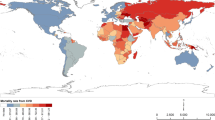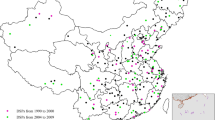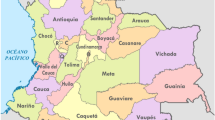Abstract
Noncommunicable diseases (NCDs) accounted for approximately 74% of all deaths globally in 2022. Among the deaths from NCDs, the leading causes is cardiovascular disease (CVD), which represents approximately 32% of all global deaths. Furthermore, estimates indicate that over three-quarters of CVD deaths occur in low- and middle-income countries such as Mexico. Therefore, the goal of this study is to analyze the spatio-temporal patterns of mortality from cardiovascular diseases across Mexican municipalities from 2010 to 2019. We used a spatial Bayesian hierarchical regression model based on the Integrated Nested Laplace Approximation (INLA) and implemented in the R-INLA package to study the spatial pattern of mortality from cardiovascular diseases in Mexican municipalities. The modeling process revealed that the best model for both populations under and over 60 years old was the spatio-temporal model with space-time interaction. Overall, the purely spatial results suggest that the relative risks for both age groups (under and over 60 years old) do not have a consistent spatial pattern in 2019. On the other hand, the spatio-temporal results show that the interactions are stronger for the population over 60 years of age. This paper demonstrates the importance of assessing not only the spatial pattern of deaths, but also simultaneously incorporating temporal trends. With the understanding that this relationship (space-time) cannot be neglected, first the results of a purely spatial model are presented and, soon after, this model is expanded and the spatio-temporal results of mortality from cardiovascular diseases across Mexican municipalities from 2010 to 2019 are shown.




Similar content being viewed by others
Data Availability
The dataset used are not publicly available due to file size but are available from the corresponding author on reasonable request.
References
Aburto, J. M. (2016). Homicides in Mexico reversed life expectancy gains for men and slowed them for women, 2000–10. Health Affairs, 2016, vol. 35, no 1, p. 88–95.
Aburto, J. M., Riffe, T., & Canudas-Romo, V. (2018). Trends in avoidable mortality over the life course in Mexico, 1990–2015: a cross-sectional demographic analysis. BMJ Open 2018;8:e022350.
Acosta-Cázares, B., & Escobedo-de la Peña, J. (2010). High burden of Cardiovascular Disease risk factors in Mexico: An epidemic of Ischemic Heart Disease that may be on its way? American Heart Journal, 160(2), 230–236.
Adair, T., & Lopez, A. D. (2020). The role of overweight and obesity in adverse Cardiovascular Disease mortality trends: An analysis of multiple cause of death data from Australia and the USA. BMC Medicine, 18, 1–11.
Anaya, G., & Al-Delaimy, W. K. (2017). Effect of the US-Mexico border region in cardiovascular mortality: Ecological time trend analysis of Mexican border and non-border municipalities from 1998 to 2012. BMC Public Health, 17(1), 1–7.
Arroyo-Quiroz, C., et al. (2020). Coronary Heart Disease mortality is decreasing in Argentina, and Colombia, but keeps increasing in Mexico: A time trend study. Bmc Public Health, 20(1), 1–10.
Banerjee, S., Carlin, B. P., & Gelfand, A. E. (2004). Hierarchical modeling and analysis of spatial data. Chapman & Hall/CRC.
Baptista, E. A., & Queiroz, B. L. (2019a). Spatial analysis of mortality by cardiovascular disease in the adult population: a study for Brazilian micro-regions between 1996 and 2015. Spatial Demography 7.1 (2019): 83–101.
Baptista, E. A., & Queiroz, B. L. (2019b). The relation between cardiovascular mortality and development: Study for small areas in Brazil, 2001–2015. Demographic Research, 41, 1437–1452.
Baptista, E. A., & Queiroz, B. L. (2022). Spatial analysis of cardiovascular mortality and associated factors around the world. BMC Public Health, 22(1), 1556.
Baptista, E. A., Kakinuma, K., & Queiroz, B. L. (2020). Association between cardiovascular mortality and economic development: a spatio-temporal study for prefectures in Japan. Int. J. Environ. Res. Public Health 2020; 17(4):1311.
Bernardinelli, L. (1995). Bayesian analysis of space–time variation in disease risk. Stat Med 1995;14(21–22):2433–43.
Besag, J., York, J., & Mollie, A. (1991). Bayesian image restoration, with two applications in spatial statistics. Ann Inst Stat Math 1991;43:1–59.
Blangiardo, M., & Cameletti, M. (2015). Spatial and spatio-temporal bayesian models with R-INLA. John Wiley & Sons.
Blangiardo, M., Cameletti, M., Baio, G., & Rue, H. (2013). Spatial and spatio-temporal models with R-INLA. Spatial and spatio-temporal Epidemiology, 4, 33–49.
CONAPO (Mexican Population Council) (2023). Conciliación demográfica de México 1950–2019 Available online: https://www.gob.mx/conapo/articulos/la-conciliacion-demografica-de-mexico. Accessed on 05 December 2023.
Cortés-Hernández, D. E. (2014). The burden of blood-pressure-related cardiovascular mortality in Mexico. International Journal of Hypertension, 2014.
Cruz, C., et al. (2017). Temporal trends in mortality from ischemic and hemorrhagic Stroke in Mexico, 1980–2012. Journal of Stroke and Cerebrovascular Diseases, 26(4), 725–732.
Dávila Cervantes, C. A. (2020b). Tendencia E Impacto De La mortalidad por enfermedades cardiovasculares en México, 1990–2015. Revista Cubana De Salud Pública, 45, e1081.
Dávila-Cervantes, C. A. (2020a). Cardiovascular Disease in Mexico 1990–2017: Secondary data analysis from the global burden of Disease study. International Journal of Public Health, 65, 661–671.
GBD (Global Burden of Disease Collaborative Network) (2019). Global Burden of Disease Study 2019 (GBD 2019) Cause-Specific Mortality 1980–2019. Institute for Health Metrics and Evaluation (IHME): Seattle, DC, USA, 2020. Available online: http://ghdx.healthdata.org/gbd-results-tool.
GBD (Global Burden of Disease Collaborative Network) (2017). Global Burden of Disease Study 2017 (GBD 2017) Cause-Specific Mortality 1980–2017. Institute for Health Metrics and Evaluation (IHME): Seattle, DC, USA, 2018. Available online: http://ghdx.healthdata.org/gbd-results-tool.
Glei, D. A. (2021). Mexican mortality 1990–2016: Comparison of unadjusted and adjusted estimates. Demographic Research, 2021, vol. 44, p. 719–758.
Gupta, R., & Wood, D. A. (2019). Primary prevention of ischaemic heart disease: populations, individuals, and health professionals. Lancet 2019;394: 685–96.
Instituto Nacional de Estadística y Geografía (INEGI) (2023). Esperanza de vida al nacimiento por entidad federativa según sexo, serie anual de 2010 a 2023. Available online: https://www.inegi.org.mx/. Accessed on 05 December 2023.
Kim, A. S., Cahill, E., & Cheng, N. T. (2015). Global Stroke belt: Geographic variation in Stroke burden worldwide. Stroke, 46(12), 3564–3570.
Knorr-Held, L. (2000). Bayesian modelling of inseparable space-time variation in Disease risk. Statistics in Medicine, 19, 2555–2567.
Lindgren, F., & Rue, H. (2015). Bayesian spatial modelling with R-INLA. Journal of Statistical Software 2015; 63: 1–25.
Lopez, A. D., & Adair, T. (2019). Is the long-term decline in Cardiovascular-Disease mortality in high-income countries over? Evidence from national vital statistics. International Journal of Epidemiology, 48(6), 1815–1823.
Luan, H., Quick, M., & Law, J. (2016). Analyzing Local Spatio-Temporal Patterns of Police Calls-for-Service Using Bayesian Integrated Nested Laplace Approximation. ISPRS International Journal of Geo-Information. 2016; 5(9):162. https://doi.org/10.3390/ijgi5090162.
Luy, M. (2010). A classification of the nature of mortality data underlying the estimates for the 2004 and 2006 United Nations’ World Population Prospects. Comparative Population Studies, 2010, 35(2).
Mehta, N. K., Abrams, L. R., & Myrskylä, M. (2020). US life expectancy stalls due to cardiovascular disease, not drug deaths. Proceedings of the National Academy of Sciences, 117(13), 6998–7000.
Meng, C. Y. K., & Dempster, A. P. (1987). A bayesian approach to the multiplicity problem for significance testing with binomial data. Biometrics, 43(2), 301–311.
Mexican Society of Demography (2010). Conciliación demográfica de México y entidades federativas 1990–2010. Mexico City: SOMEDE-CONAPO, 2010.
Nowbar, A. N., et al. (2014). 2014 global geographic analysis of mortality from ischaemic Heart Disease by country, age and income: Statistics from World Health Organisation and United Nations. International Journal of Cardiology, 174(2), 293–298.
Okwuosa, I. S., et al. (2016). Worldwide disparities in Cardiovascular Disease: Challenges and solutions. International Journal of Cardiology, 202, 433–440.
Partida, V. (2017). Conciliación demográfica De México 1950–2015. Consejo Nacional De Población, El Colegio De México, Sociedad Mexicana De Demografía. Fondo de Población de las Naciones Unidas.
Phillips, D. E. (2014). A composite metric for assessing data on mortality and causes of death: the vital statistics performance index. Population health metrics, 2014, vol. 12, p. 1–16.
Queiroz, B. L. (2020). Comparative analysis of completeness of death registration, adult mortality and life expectancy at birth in Brazil at the subnational level. Population health metrics, 2020, vol. 18, p. 1–15.
Reddy, K. S. (2002). Cardiovascular Diseases in the developing countries: Dimensions, determinants, dynamics and directions for public health action. Public Health Nutrition, 5(1a), 231–237.
Roth, G. A. (2017a). Global, regional, and national burden of cardiovascular diseases for 10 causes, 1990 to 2015. J. Am. Coll. Cardiol 2017, 70, 1–25.
Roth, G. A. (2017b). Trends and patterns of geographic variation in cardiovascular mortality among US counties, 1980–2014. JAMA 2017, 317, 1976–1992.
Roth, G. A., et al. (2020). Global burden of Cardiovascular Diseases and risk factors, 1990–2019: Update from the GBD 2019 study. Journal of the American College of Cardiology, 76(25), 2982–3021.
Rue, H., Martino, S., & Chopin, N. (2009). Approximate Bayesian inference for latent Gaussian models by using integrated nested Laplace approximations. Journal of the Royal Statistical Society: Series B (Statistical Methodology) 2009;71(2):1–35.
Sparks, P. J., Sparks, C. S., & Campbell, J. J. (2013). An application of bayesian spatial statistical methods to the study of racial and poverty segregation and infant mortality rates in the US. Geojournal, 78(2), 389–405.
Spiegelhalter, D. J., et al. (2002). Bayesian measures of model complexity and fit. J R Stat Soc Ser B Stat Methodol, 64(4), 583–616.
The World Bank (2023). Completeness of death registration with cause-of-death information (%). Available online: https://data.worldbank.org/indicator/SP.REG.DTHS.ZS?locations=MX (accessed on 05 December 2023).
United Nations (2021). Sustainable development goal 3: ensure healthy lives and promote well-being for all at all ages. United Nations. https://sustainabledevelopment.un.org/sdg3 (accessed on 02 December 2022).
Wakefield, J., & Lyons, H. (2010). Spatial aggregation and the ecological fallacy. In A. E. Gelfand, P. Diggle, P. Gultorp, & M. Fuentes (Eds.), Handbook of spatial statistics (pp. 541–558). Chapman & Hall/CRC.
Wang, H. (2017). Global, regional, and national under-5 mortality, adult mortality, age-specific mortality, and life expectancy, 1970–2016: a systematic analysis for the Global Burden of Disease Study 2016. The Lancet, vol. 390, no 10100, p. 1084–1150.
World Health Organization (2021). Cardiovascular diseases (CVDs). Available online: https://www.who.int/news-room/fact-sheets/detail/cardiovascular-diseases-(cvds) (accessed on 13 July 2023).
World Health Organization (2022). Noncommunicable diseases. Available online: https://www.who.int/news-room/fact-sheets/detail/noncommunicable-diseases (accessed on 13 July 2023).
Yusuf, S. (2004). Effect of potentially modifiable risk factors associated with myocardial infarction in 52 countries (the INTERHEART study): case–control study. Lancet. 2004;364(9438):937–52.
Zhao, D., et al. (2015). Cardiovascular risk assessment: A global perspective. Nature Reviews Cardiology, 12(5), 301–311.
Acknowledgements
Not applicable.
Funding
This research did not receive any specific grant from funding agencies in the public, commercial, or not-for-profit sectors.
Author information
Authors and Affiliations
Corresponding author
Ethics declarations
Ethics approval and consent to participate
Not applicable.
Consent for publication
Not applicable.
Competing Interests
The author declares that there are no competing interests.
Additional information
Publisher’s Note
Springer Nature remains neutral with regard to jurisdictional claims in published maps and institutional affiliations.
Electronic Supplementary Material
Below is the link to the electronic supplementary material.
Rights and permissions
Springer Nature or its licensor (e.g. a society or other partner) holds exclusive rights to this article under a publishing agreement with the author(s) or other rightsholder(s); author self-archiving of the accepted manuscript version of this article is solely governed by the terms of such publishing agreement and applicable law.
About this article
Cite this article
Baptista, E.A. Cardiovascular Diseases Mortality in Mexican Municipalities: A Spatio-Temporal Approach. Appl. Spatial Analysis (2024). https://doi.org/10.1007/s12061-023-09562-7
Received:
Accepted:
Published:
DOI: https://doi.org/10.1007/s12061-023-09562-7




